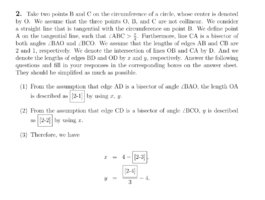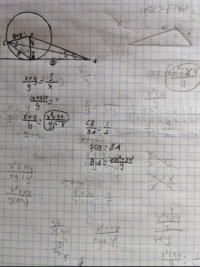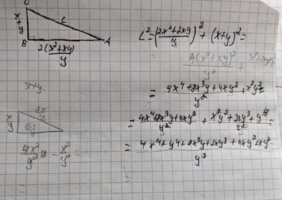You are using an out of date browser. It may not display this or other websites correctly.
You should upgrade or use an alternative browser.
You should upgrade or use an alternative browser.
How do i solve this? Circle w/ center O, points B, C on circumference, B, C, O not collinear
- Thread starter Felix_GG
- Start date
blamocur
Elite Member
- Joined
- Oct 30, 2021
- Messages
- 2,627
I couldn't understand your formulae, but for "2-1" I'd use https://en.wikipedia.org/wiki/Angle_bisector_theorem
I didn't used any complicated formula, i tried to solve by logic, didn't go quite well. But i did tried the one you've suggested. That's how i got CB.I couldn't understand your formulae, but for "2-1" I'd use https://en.wikipedia.org/wiki/Angle_bisector_theorem
blamocur
Elite Member
- Joined
- Oct 30, 2021
- Messages
- 2,627
A general point: the time it would get you to write your work in a cleaner and more explicit form is probably less than it takes us to decipher it.
What did you get for CB?
And another question: what is your answer for 2-1, i.e., the length of OA ?
That's how i got CB.
What did you get for CB?
And another question: what is your answer for 2-1, i.e., the length of OA ?
After CB, I got BA. After that I tried to find OA by Pythagorean theorem, but couldn't. I don't know why.A general point: the time it would get you to write your work in a cleaner and more explicit form is probably less than it takes us to decipher it.
What did you get for CB?
And another question: what is your answer for 2-1, i.e., the length of OA ?
blamocur
Elite Member
- Joined
- Oct 30, 2021
- Messages
- 2,627
I don't either since you don't even answer my questions. Looks like I can't be of much help in this mode.I don't know why.
You say that this is the right way to find AO, am i correct? if that so, i will recheck and try again, i already had tried twice, and answer was always the same. I still looking for answer, i tried to find a video about people solving similar problems, but there seem to be no such video. Please, i would be satisfied just by a small hint.I don't either since you don't even answer my questions. Looks like I can't be of much help in this mode.
HOW did you evaluate CB, BA and OA? Please post (share) detailed work. Please define all the variables - explicitly. Use a fresh sheet of paper and dark pen. Please donot write over your mistakes. Cut the mistake out with one-line and write again.After CB, I got BA. After that I tried to find OA by Pythagorean theorem, but couldn't. I don't know why.
I suggest you put the origin at B. Then you will have BA = x and BO = y. Then continue...
A clean step-by-step presentation of Your work will guide us to help you most effectively.
blamocur
Elite Member
- Joined
- Oct 30, 2021
- Messages
- 2,627
I asked you two specific questions, but never got any answers or shown any attempt to get those answers. The questions were intended as hints which you asked for.You say that this is the right way to find AO, am i correct?
If you really need help please post your attempts to answer my questions, and please try to make clean drawings and readable explanations. In my experience making clear drawings and writing down clear (attempts at) answers often helps me to see what I was missing before.
Yeah, you are right. That's my mistake. here, i rewrote, if there is still something hard to see, i will make it clear.I asked you two specific questions, but never got any answers or shown any attempt to get those answers. The questions were intended as hints which you asked for.
If you really need help please post your attempts to answer my questions, and please try to make clean drawings and readable explanations. In my experience making clear drawings and writing down clear (attempts at) answers often helps me to see what I was missing before.
The next step should have been taking root of whole equation, but i think nothing good will happen.
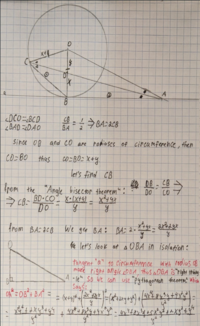
blamocur
Elite Member
- Joined
- Oct 30, 2021
- Messages
- 2,627
Thank you for a much clearer writeup and drawing. Now some notes/questions:
- You say "let's find CB", but the problem's statement says that CB = 1
- One thing, i.e. item 1), at a time: how can you express the length of OA through 'x' and 'y' knowing that AB = 2?
OH MY GOD. I'm so sorry, i thought that "1 and 2" was reffered to ratio of AB and CB, like: if CB is 4 (cm) then AB is 8 (cm) or AB is 5 (cm) then CB is 2.5 (cm). I didn't pay enough attention to notice, that the talk was about their length! My English is still not that good, so possibly that word just slipped my mind. I will immediately try to redo everything and finaly get the answer by myself.Thank you for a much clearer writeup and drawing. Now some notes/questions:
- You say "let's find CB", but the problem's statement says that CB = 1
- One thing, i.e. item 1), at a time: how can you express the length of OA through 'x' and 'y' knowing that AB = 2?
Yay, i managed to get two answers, but i have no idea how to get the third and the fourth ones.Thank you for a much clearer writeup and drawing. Now some notes/questions:
- You say "let's find CB", but the problem's statement says that CB = 1
- One thing, i.e. item 1), at a time: how can you express the length of OA through 'x' and 'y' knowing that AB = 2?
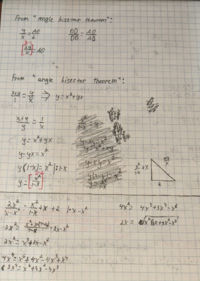
Below the line is my attempt of getting the third answer. Use triangle on right as reference:
Firstly i put the value of "y" in equation of "AO" and tried to think up a solution, but answer won't work out. i don't knoww any other way to find "x" or "y". I tried to use the same bisector theorem but it didn't worked too.
blamocur
Elite Member
- Joined
- Oct 30, 2021
- Messages
- 2,627
I cannot figure out your equations there, but I agree with your answers for (1) and (2).Below the line is my attempt of getting the third answer. Use triangle on right as reference:
Firstly i put the value of "y" in equation of "AO" and tried to think up a solution, but answer won't work out. i don't knoww any other way to find "x" or "y". I tried to use the same bisector theorem but it didn't worked too.
You already can express 'y' through 'x', and you have one equation for AO in terms of 'x' and 'y'. But you can get another equation for AO using the fact tat ABO is a right triangle. I believe I've found solutions for 'x' and 'y' by using [imath]u=x+y[/imath] and solving first for 'u', then for 'x' and 'y'. But I have no clue why they want you to get those answers in the form described in (3) -- there might be some specific technique which they taught you and which I am not aware of.
This actually a trial test of Japanese university entry exam. I'm not a japanese and I also don't understand how to get those answers. I was never taught any technique, that's why I'm seeking for somebody who is familiar with japanese math. But you already was a big big help. I think I will repost this problem, to find somebody to help me.I cannot figure out your equations there, but I agree with your answers for (1) and (2).
You already can express 'y' through 'x', and you have one equation for AO in terms of 'x' and 'y'. But you can get another equation for AO using the fact tat ABO is a right triangle. I believe I've found solutions for 'x' and 'y' by using [imath]u=x+y[/imath] and solving first for 'u', then for 'x' and 'y'. But I have no clue why they want you to get those answers in the form described in (3) -- there might be some specific technique which they taught you and which I am not aware of.
blamocur
Elite Member
- Joined
- Oct 30, 2021
- Messages
- 2,627
Can you try solving it for 'x' and 'y' without worrying about the format of (3) ?This actually a trial test of Japanese university entry exam. I'm not a japanese and I also don't understand how to get those answers. I was never taught any technique, that's why I'm seeking for somebody who is familiar with japanese math. But you already was a big big help. I think I will repost this problem, to find somebody to help me.
P.S. I have no clue about Japanese math, but I suspect they do recognize general rules of algebra
Sorry, I don't really understand what do you mean. I already found "y", didn't I?Can you try solving it for 'x' and 'y' without worrying about the format of (3) ?
P.S. I have no clue about Japanese math, but I suspect they do recognize general rules of algebra
blamocur
Elite Member
- Joined
- Oct 30, 2021
- Messages
- 2,627
Do you mean expressing 'y' through 'x' ? That would not be enough since (3) wants you to find solutions for both 'x' and 'y', not just a dependency between them. Or did I miss it somehow?Sorry, I don't really understand what do you mean. I already found "y", didn't I?
Dr.Peterson
Elite Member
- Joined
- Nov 12, 2017
- Messages
- 16,093
It appears that you are using the right triangle shown, but assuming that a + b = c rather than a^2 + b^2 = c^2, the Pythagorean Theorem.Yay, i managed to get two answers, but i have no idea how to get the third and the fourth ones.View attachment 35747
Below the line is my attempt of getting the third answer. Use triangle on right as reference:
Firstly i put the value of "y" in equation of "AO" and tried to think up a solution, but answer won't work out. i don't knoww any other way to find "x" or "y". I tried to use the same bisector theorem but it didn't worked too.
Correct that, and you should be able to solve for x:
I'd simplify before squaring.

